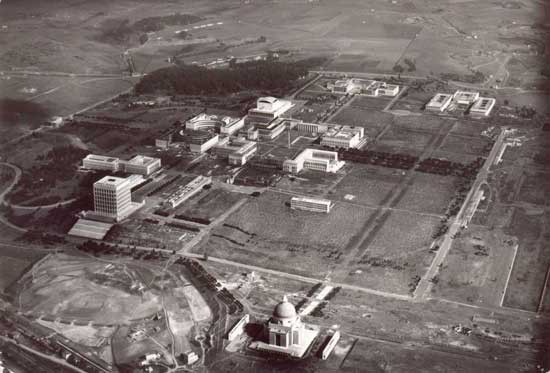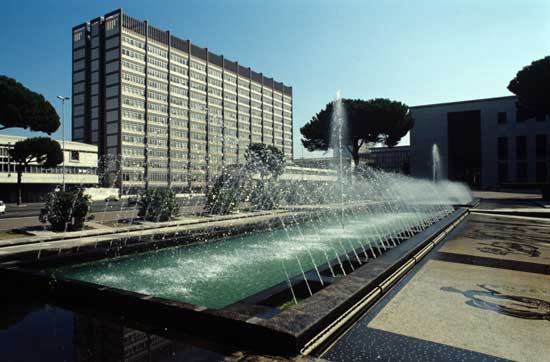Maybe you have heard about it but you probably never went or happened to pass by this area during your stay in the Capital. It is an area of Rome whose building physiognomy dates back to the Fascist period: the EUR.

We are in the thirties of the twentieth century and Mussolini clearly expresses his will to initiate a unique construction project, fit to host the World Exposition, to be held in 1942. The war clearly put an end to this intent, without however preventing the area from writing its own history, and still standing for a very active urban area.
The original name planned for this celebratory space shows a link with the Universal Exhibition. The EUR should have been, in fact, called E42 in reference to the year of its realization. EUR is an abbreviation, an acronym that stands for: Universal Exposition Rome.

Over the years, the neighbourhood developed increasingly, welcoming new buildings and urban spaces, becoming a modern and functional district. Here, architecture enthusiasts can observe buildings that date back to the fascist period, in its typical clear cut, essential and at the same time monumental style, characteristic of the time, of which the “Palazzo della Civiltà Italiana” also known as “Palazzo della Civiltà del Lavoro” with its overlapping arches and the “Palazzo dei Congressi” are a clear example.
The Palazzo della Civiltà Italiana was designed in 1937 by Giovanni Guerrini, Ernesto Lapadula and Mario Romano and, still today, it stands as a particularly rational and celebratory construction, so much so that it is generally called the “Square Coliseum“. It is situated in a urban area known as the Square of Concord, it has a square architectural plan and is made of reinforced concrete and travertine. Even the choice of travertine shows a willingness to ideologically reconnect with the historical tradition of the Roman Empire.
The building looks like a box with four facades and arches. With its countless arches, indeed, the Palazzo della Civiltà Italiana can only recall the aesthetics of the Coliseum in Rome and probably this reference to the monument, for which Rome is famous all over the world, is intentional within the ideology promoted by Mussolini. The building has been declared by the Ministry of Heritage and Culture and Tourism a testimony of cultural interest.

The “Palazzo dei Congressi” too is an interesting example of architecture from the fascist era, also in regard to its interior spaces. Designed mainly by Adalberto Libera, it owes its interior decoration to Achille Funi and to the Futurist artist, Gino Severini. Today it is used as an exhibition space or as a container for various events. Characterizing the “Palazzo dei Congressi” are the marble interiors together with the works of art therein. In the Kennedy foyer, for example, right at the entrance of the building, you can admire a fresco of the origins of the city of Rome, linked to the name of Achille Funi.
Finally, if, walking around EUR, you encounter an obelisk, know that is a modern monument. Created by Arnaldo Pomodoro, it is rightfully called “Twentieth Century”: more contemporary than that! This 21 meters high obelisk is a spiral tower that symbolically represents the idea of movement and progress. If you decide to spend some time in this area of Rome and walk away from the city centre, you cannot miss visiting the Planetarium, located in this area, or even make an afternoon visit to the famous Laghetto (small lake), home to several ducks, in a quiet and relaxing green environment.


